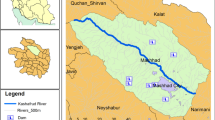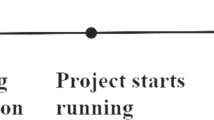Abstract
Major water resources allocation projects (MWRAP) are large-scale complex ventures with long construction periods and involve many stakeholders. In practice, the “Dilemma of Collaborative Action” often exists in the construction of MWRAP due to the contradictions and conflicts between various participants, with coordination failure. Despite realizing the importance of MWRAP, the current research still lacks a deep understanding of related organizational issues. Adopting network governance theory (NG) as a point of departure, this study first reviewed the classic NG and current research status systematically. To solve the “Dilemma of Collaborative Action”, the classic NG was then introduced to the context to construct a four-party mathematical model, which emphasizes the cooperation among government, (In this research, the central government, local government, and government agencies are collectively called “government”) project owner, contractor, and consultant and can maximize the performance of MWRAP. A network governance framework across individual, group, project and organizational fields was elaborated for NG research in MWRAP, and future research directions in this area were proposed and discussed. At the same time, it anatomizes the control rights and effort level of the four-party participants and their influences on the performance of MWRAP. The performance can be improved only when the control rights and effort level are in effective ranges. All these conclusions are done well by data simulation. This research not only bridges the research gap in MWRAP governance from a new perspective but also contributes to the enrichment and development of NG in a new context.




Similar content being viewed by others
Data Availability
Some or all data, models, or code that support the findings of this study are available from the corresponding author upon reasonable request.
References
Adami VS, Verschoore JR (2018) Implications of network relations for the governance of complex projects. Proj Manag J 49(2):71–88
Adeniran AB, Daniell KA (2021) Transaqua: Power, political change and the transnational politics of a water megaproject. Int J Water Resour Dev 37(2):234–255
Ahn M, Baldwin E (2022) Who benefits from collaborative governance? An empirical study from the energy sector. Public Manag Rev 03–16
Albareda L, Waddock S (2018) Networked CSR governance: A whole network approach to meta-governance. Bus Soc 57(4):636–675
Bianchi C, Nasi G, Rivenbark WC (2021) Implementing collaborative governance: models, experiences, and challenges. Public Manag Rev 03–21
Bajany DM, Zhang L, Xu Y et al (2021) Optimisation approach toward water management and energy security igions. Environ Process 8:1455–1480
Chen X, You QG, Wang Y (2018) Analysis of the beneficial influence of major water conservancy project construction on economic growth. Water Resour Dev Res 18(3):10–14
Chen XK (2018) Application of ‘PPP+EPC’ investment- construction- management mode in large water infrastructure construction—a case study of Maling Water Complex in Guizhou Province. China Water Resour 844(10):58–61
Dai X (2020) Construction and practice of ‘top-level design and cooperative governance’ watershed management model: From Tennessee River to Yellow River. Future Dev 44(9):95–101
Fedorowicz J, Sawyer S, Tomasino A (2018) Governance configurations for inter-organizational coordination: A study of public safety networks. J Inf Technol 33(4):326–344
Ge W, Jiao YT, Li ZK et al (2020) Risk evaluation of land requisition and resettlement of major linear water conservancy projects. Yellow River 42(12):129–134
Goldsmith S, Eggers WD (2005) Governing by network: The new shape of the public sector. Brookings Institution Press
Guo T, Dong J, Ren X et al (2017) The core enterprise network competence, network characteristics and the innovation network governance performance - from Chinese microcosmic evidence. Eurasia J Math Sci Technol Educ 13(12):7823–7833
Huang C, Yi HT, Chen T, Xu XL, Chen SY (2020) Networked environmental governance: formal and informal collaborative networks in local China. Policy Stud 1–19
Huang XC, Zhou LA (2019) ‘Paired Competition’: A new mechanism for the innovation of urban local governance. Chinese J Sociol 39(05):1–38
Jacobson DD (2016) How and why network governance evolves: Evidence from a public safety network. Electron Mark 26(1):43–54
Jiang T (2021) Network governance—a new framework for public administration. Manag Technol SM 1:27–28
Jones C, Hesterly WS, Borgatti SP (1997) A general theory of network governance: Exchange conditions and social mechanisms. Acad Manag Rev 22(4):911–945
Le Y, Huang YZ, Wei JF (2017) Evolution of organization pattern for government investment mega project. J Eng Manag 31(2):54–58
Li CL, Li HF, Zhang Y, Zha DD, Zhao BB et al (2019) Predicting hydrological impacts of the Yangtze-to-Huaihe Water Diversion Project on habitat availability for wintering waterbirds at Caizi Lake. J Environ Manag 249
Li HM, Arditi D, Wang ZF (2015) Determinants of transaction costs in construction projects. J Civ Eng Manag 21(5):548–558
Li HY (2017) Evolutionary game analysis of emergency management of the middle route of south-to-north water diversion project. Water Resour Manag 31(9):2777–2789
Li J (2020) ‘Dilemma of Collaborative Action’ and its solutions in regional governance-taking collaborative governance of air pollution in Beijing-Tianjin-Hebei region as an example. Administrative Forum 27(05):146–152
Li Q, Chong HY, Lee CY, Zhang YB (2021) BIM’s formal and informal collaborative networks in traditional procurement: insights from the construction phase of a hospital case study. J Manag Eng 37(6):05021008
Li YK, Chang C, Li B (2020) Diversified spatio- temporal evolution of innovation collaboration meta- networks in megaprojects. Sci Res Manag 41(10):98–104
Loukis E, Janssen M, Dawes S et al (2016) Evolving ict and governance in organizational networks - conceptual and theoretical foundations. Electron Mark 26(1):7–14
Ma TY, Ding JY, Wang ZF et al (2020) Governing government-project owner relationships in water megaprojects: A concession game analysis on allocation of control rights. Water Resour Manag 34(13):4003–4018
Martinsen G, Liu S, Mo X et al (2019) Optimizing water resources allocation in the Haihe River Basin under groundwater sustainability constraints. J Geog Sci 29(6):935–958
Meyer W (2006) Evaluation of Network Governance. Zeitschrift Fur Eval (2):0–317
Müller M (2011) State dirigisme in megaprojects: Governing the 2014 winter olympics in Sochi. Environ Plan A 43(9)
Nindyatmoko A, Setyowati K, Haryanti RH (2022) Collaboration after conflict: A lesson from collaborative action in customary land tenure conflicts in Lombok, Indonesia. Forest and Society 6(1):294–310
Nochta T, Skelcher C (2020) Network governance in low-carbon energy transitions in European cities: A comparative analysis. Energy Policy 138
Nong XZ, Shao DG, Zhong H, Liang JK (2020) Evaluation of water quality in the South-to-North Water Diversion Project of China using the water quality index (WQI) method. Water Res 178
Pauget B, Wald A (2013) Relational Competence in Complex Temporary Organizations: the Case of a French Hospital Construction Project Network. Int J Proj Manag 31(2)
Peng ZY (2002) Research on the theory of network governance. China Soft Sci 3:50–54
Pittman J, Armitage D (2019) Network governance of land-sea social-ecological systems intilles. Ecol Econ 157:61–70
Rollason E, Sinha P, Bracken LJ (2022) Interbasin water transfer in a changing world: A new conceptual model. Prog Phys Geogr-Earth Environ 03091333211065004
Romiti A, Del Vecchio M, Sartor G (2021) Network governance forms in healthcare: empirical evidence from two Italian cancer networks. BMC Health Serv Res 20(1)
Sheng ZH, Cheng SP, Li Q et al (2020) ‘Governance of China’ in decision-making governance of major projects. Manag World 36(6):202–212, 254
Shumilova O, Tockner K, Thieme M, Koska A, Zarfl C (2019) Global water transfer megaprojects: A potential solution for the water-food-energy nexus? Front Environ Sci 6
Sun L, Sun SR (2016) Interest conflicts and governance mechanism caused by major infrastructure project. J Ind Eng Eng Manag 30(1):34–42
Tao Y (2021) Towards network governance: educational reforms and governance changes in China (1985–2020). Asia Pac Educ Rev 22:1–14
Veena S, Singh R, Gold D, Reed P, Bhave A (2021) Improving information-based coordinated operations in Interbasin Water Transfer Megaprojects: Case study in Southern India. J Water Resour Plan Manag 147(11)
Wang HM, Ran B (2021) Network governance and collaborative governance: A thematic analysis on their similarities, differences, and entanglements. Public Manag Rev 12–10
Wang K (2019) Analysis of forest resource governance model from the perspective of network governance. World For Res 32(3):13–17
Wang XY, Liu L, Zhang SL (2021) Integrated model framework for the evaluation and prediction of the water environmental carrying capacity in the Guangdong-Hong Kong-Macao Greater Bay Area. Ecol Indic 130
Wei SY, Li FY (2016) Countermeasures on extreme incidents of social venting anger in China form the theory of network governance. J Beijing Admin Inst 4:85–92
Xu YD, Wang MY, Yang YJ (2019) Research on construction management mode and application process of hydraulic engineering based on BIM. Yellow River 41(8):138–143
Yan L, Zhang YQ, Tang JD (2021) Research on organization structure and control system construction of life cycle engineering consulting project. Constr Econ 42(1):28–34
Yu ZW, Zhang BS (2010) A summary of theoretical basic research on network governance. Stat Decis 23:174–176
Zhang CK, Bing N, Zhu HN (2015) Game theory and information economics. Posts Telecom Press 205:06
Zhang Q, Song YF (2018) Network governance—the governance plan from the integration perspective. J Chongqing Univ Arts Sci (Soc Sci Ed) 37(3):76–83
Zhong KB, Lu XL (2018) Exploring the administrative mechanism of China’s Paired Assistance to Disaster Affected Areas program. Disasters 42(3):590–612
Zhu XN, Zhu SF (2015) On development of network governance with the involvement of urban communities. Proceedings of 2015 International Conference on Public Administration (11th), Vol Ii: University of Electronic Science and Technology of Chinese Press (uestc Press), pp 433–438
Acknowledgements
We are particularly grateful to the anonymous reviewers and editors for their comments.
Funding
This research is funded by Postgraduate Research & Practice Innovation Program of Jiangsu Province (KYCX21_0440), the Fundamental Research Funds for the Central Universities (No. B210203063), and the National Social Science Foundation of China (No. 19FJYB004). We also appreciate the financial support from the China Scholarship Council (No. 202006710037).
Author information
Authors and Affiliations
Contributions
W.J. ZHAI conceived and designed the study, and built the framework. J.Y. DING and L.J. DING completed the paper in English and revised it critically for important intellectual content. Z.F. WANG gave many good research advice and revised the manuscript. All authors have read and agreed to the published version of the manuscript.
Corresponding author
Ethics declarations
Conflicts of Interest
The authors declare no conflicts of interest.
Competing Interest
The authors have no relevant financial or non-financial interests to disclose.
Additional information
Publisher's Note
Springer Nature remains neutral with regard to jurisdictional claims in published maps and institutional affiliations.
Rights and permissions
About this article
Cite this article
Zhai, W., Ding, J., Wang, Z. et al. Performance and Participants’ Decisions Analysis in Major Water Resources Allocation Project Based on Network Governance. Water Resour Manage 36, 2455–2470 (2022). https://doi.org/10.1007/s11269-022-03153-w
Received:
Accepted:
Published:
Issue Date:
DOI: https://doi.org/10.1007/s11269-022-03153-w




